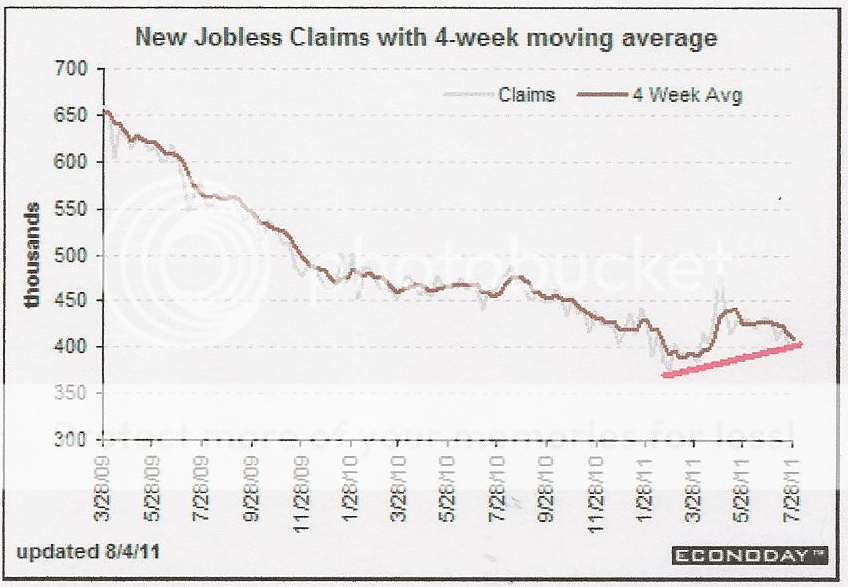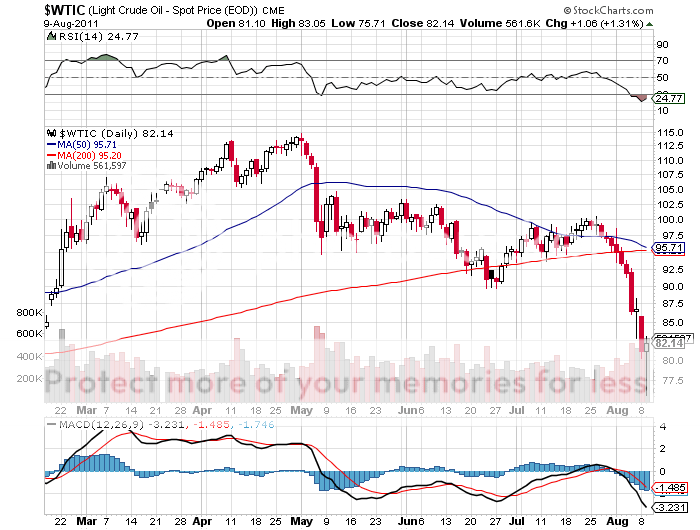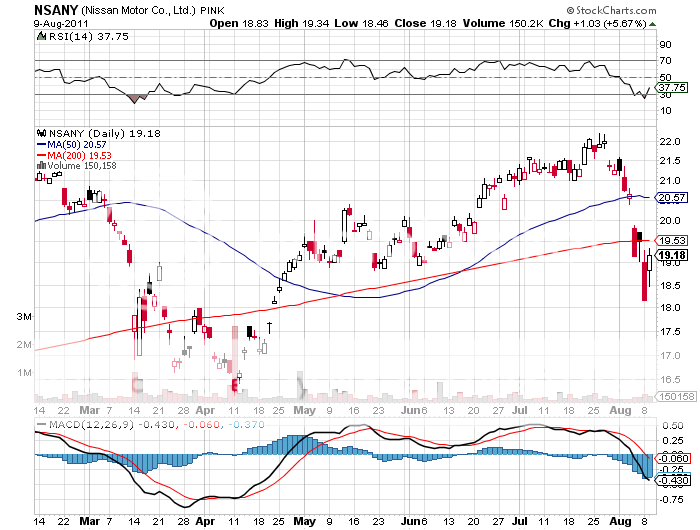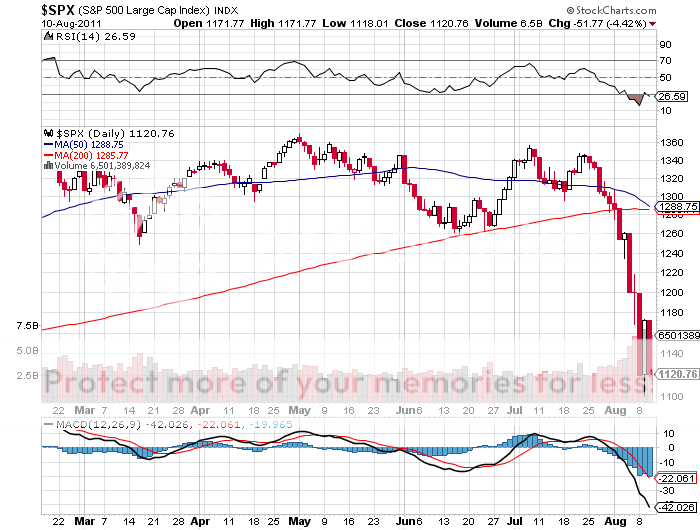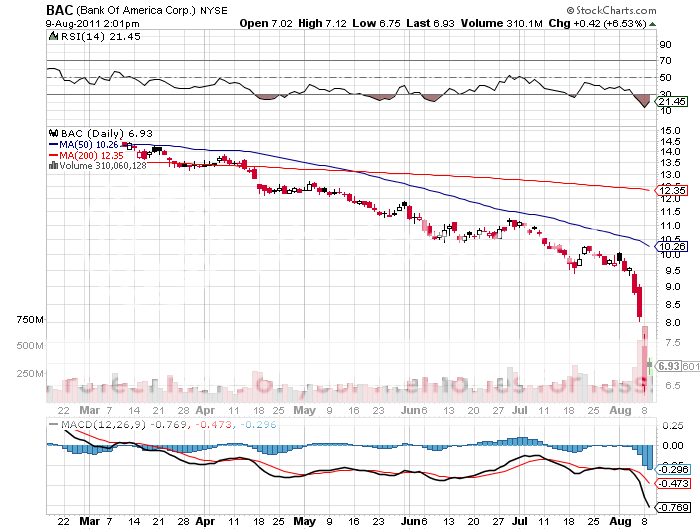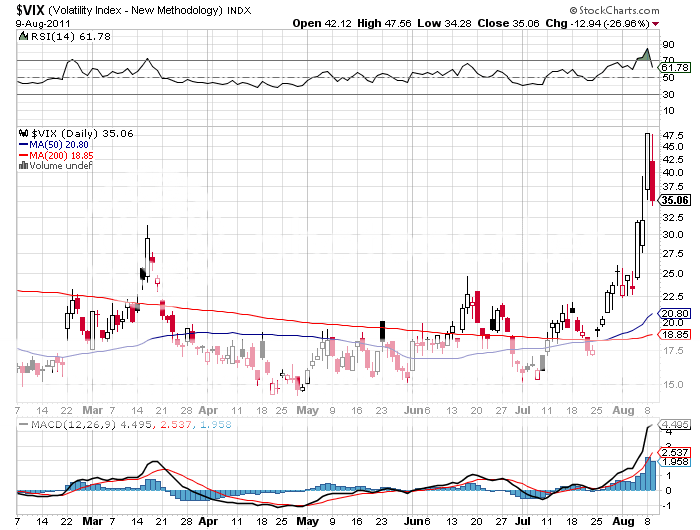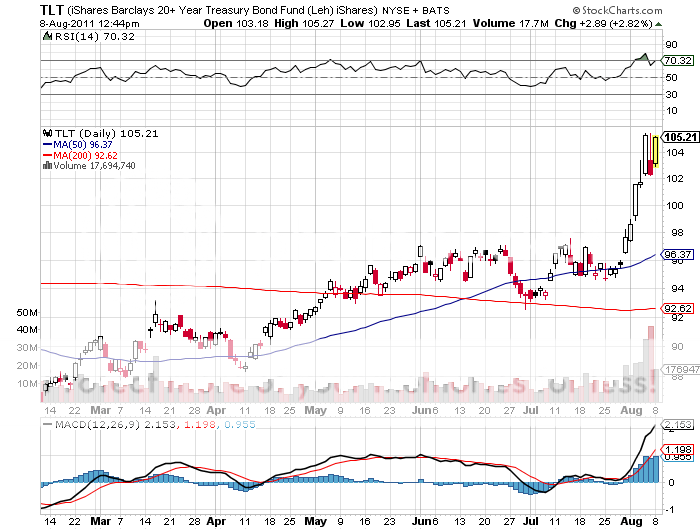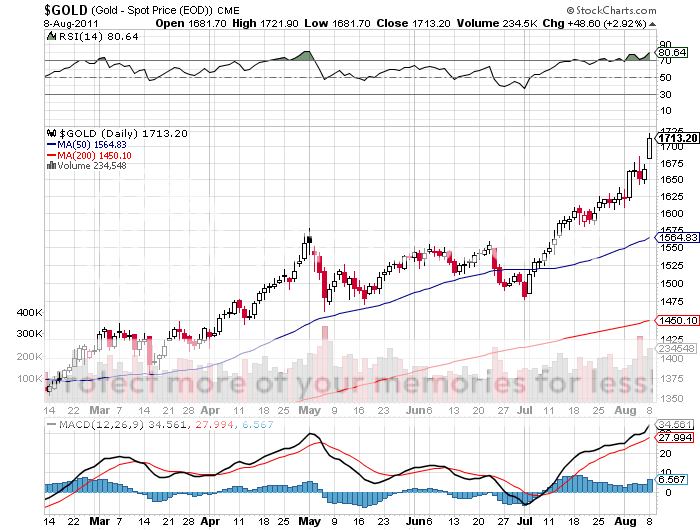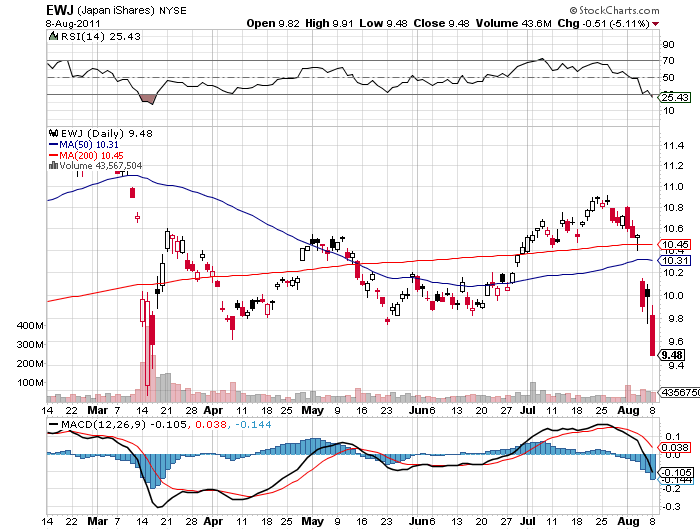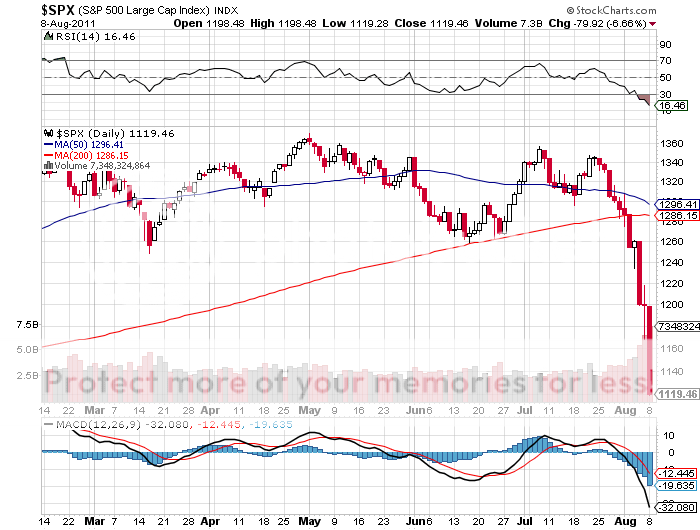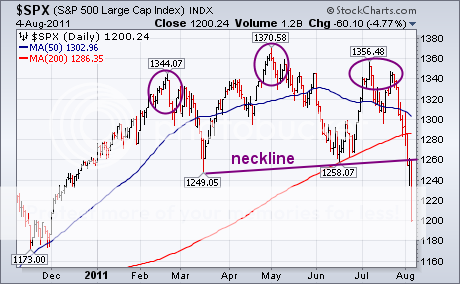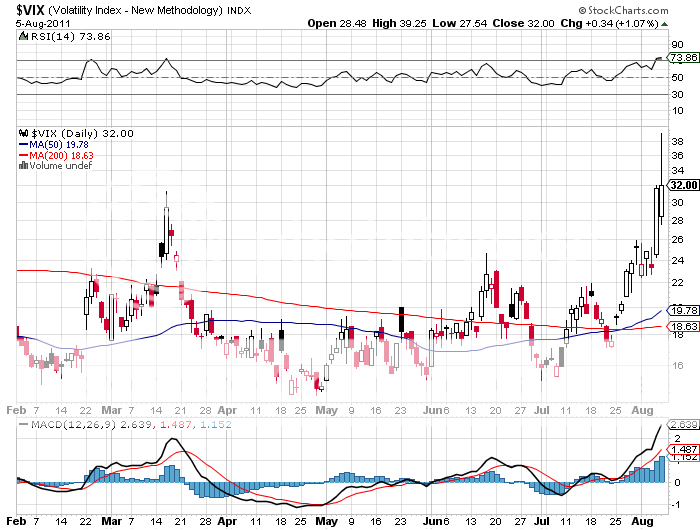
Featured Trades: (JOBLESS CLAIMS SEND BEARS FLEEING)
1) Jobless Claims Send Bears Fleeing. The single most important coincident indicator you can follow, the weekly jobless claims, showed a modest improvement, sending bears fleeing.
The figures released at 8:30 am EST every Thursday had claims fall by 7,000 to 395,000. This is the third consecutive week that claims have been at or below the crucial 400,000 level. The four week moving average moved down by 3,250.
The data reflects new hiring by the auto industry, which now seems on tracks to reach a healthy 13.5 million units this calendar year. The rapid recovery in Japan is also having a positive pull on the numbers. It is further evidence that the world economy is better than the stock market is indicating. The daily 600 point swings are starting to look more like a market 'accident' than an indicator of the future earning power of US corporations.
The improving trend is likely to spur some portfolio managers to move off the bench where they have been frozen in dropped jaw amazement and into 'BUY' mode. Interest rates are now pegged at zero for two more years, the year Treasury bond yield is hovering above 2.0%, and PE Multiples have just crashed from 15 to 11, the bottom of a multiyear range. At the worst of the 2008-2009 crash, earnings multiples spent only a few nanoseconds at the 9 level. Not to do so requires them to take all of their time-tested investment models and toss them out the window.
-
There Goes My Model
Featured Trades: (THE TRUE COST OF OIL)
2) The True Cost of Oil. I received some questions last week on my recent solar pieces as to whether I minded paying more money for 'green' power. My answer is 'hell no,' and I'll tell you why. My annual electric bill comes to $1,500 a year. Since the California power authorities have set a goal of 33% alternative energy sources by 2020, PG&E (PGE) has the most aggressive green energy program in the country (click here for 'The Solar Boom in California'). More expensive solar, wind, geothermal, and biodiesel power sources mean that my electric bill may rise by $150-$300 a year.
Now let's combine my electricity and gasoline bills. Driving 15,000 miles a year, my current gasoline engine powered car uses 750 gallons a year, which at $3/gallon for gas costs me $2,250/year. So my annual power/gasoline bill is $3,750. My new Nissan Leaf (NSANY) will cost me $180/year to cover the same distance (click here for 'Getting Something for Nothing'). Even if my power bill goes up 20%, as it eventually will, thanks to the Leaf, my power/gasoline bill plunges to $1,980, down 47%.
There is an additional sweetener which I'm not even counting. I also spend $1,000/year on maintenance on my old car, including tune ups and oil changes. The Nissan Leaf will cost me next to nothing, as there are no oil changes or tune ups, and my engine drops from using 250 parts to just five. We're basically talking brake pads and tires for the first 100,000 miles.
There is a further enormous pay off down the road. We are currently spending $100 billion a year in cash up front fighting our wars in the Middle East, or $273 million a day! Add to that another $200 billion in back end costs, including wear and tear on capital equipment, and lifetime medical care for 3 million veterans, some of whom are severely messed up.
We import 9.1 million barrels of oil each day, or 3.3 billion barrels a year, worth $270 billion at $82/barrel. Some 2 million b/d, or 730 million barrels/year worth $60 billion comes from the Middle East. That means we are paying a de facto tax which amounts to $136/barrel, taking the true price for Saudi crude up to a staggering $219/barrel!
We are literally spending $100 billion extra to buy $60 billion worth of oil, and that's not counting the lives lost. Even worse, all of the new growth in Middle Eastern oil exports is to China, so we are now spending this money to assure their supplies more than ours. Only a government could come up with such an idiotic plan.
There is another factor to count in. Anyone in the oil industry will tell you that, of the current $82 price for crude, $30 is a risk premium driven by fears of instability in the Middle East. The Strategic Petroleum Reserve, every available tanker, and thousands of rail cars are all chocked full with unwanted oil. This is why prices remain high.
The International Energy Agency says the world is now using 87 million b/d, or 32 billion barrels a year worth $2.6 trillion. This means that the risk premium is costing global consumers $950 billion/year. If we abandon that oil source, the risk premium should fall substantially, or disappear completely. What instability there is becomes China's headache, not ours.
If enough of the country converts to alternatives and adopts major conservation measures, then we can quit importing oil from that violent part of the world. No more sending our president to bow and shake hands with King Abdullah. Oil prices would fall, our military budget would drop, the federal budget deficit would shrink, and our taxes would likely get cut.
One Leaf shrinks demand for 750 gallons of gasoline, or 1,500 gallons of oil per year. That means that we need 20.4 million Leafs on the road to eliminate the need for the 2 million barrels/day we are importing from the Middle East. The Department of Energy has provided a $1.6 billion loan to build a Nissan plant in Smyrna, Tennessee that will pump out 150,000 Leafs a year by end 2012. Add that to the million Volts, Tesla S-1's, is Mitsubishi iMiEV's hitting the market in the next few years. Also taking a bite out of our oil consumption are the 1 million hybrids now on the road to be joined by a second million in the next two years. That goal is not so far off.
Yes, these are simplistic, back of the envelop calculations that don't take into account other national security considerations, or our presence on the global stage. But these numbers show that even a modest conversion to alternatives can have an outsized impact on the bigger picture.
By the way, please don't tell ExxonMobile (XOM) or BP (BP) I told you this. They get 80% of their earnings from importing oil to the US. I don't want to get a knock on the door in the middle of the night.
-
-
-
-
Is $219 Oil Worth This?
-
Or This?
-
Will it Be a Nissan Leaf?
-
A Volt?
-
A Tesla S-2?
-
Or a Mitsubishi iMiEV?
-
Featured Trades: (BERNANKE SAYS BUY STOCKS, OR ELSE!)
2) Bernanke Says Buy Stocks, Or Else! I believe that the risk markets are discounting a recession that isn't going to happen. Not yet, anyway. So I am going to start adding some small, limited risk call options here.
After analyzing the statement from the Federal Reserve yesterday, it is clear that Ben Bernanke is holding a gun to your head, threatening to pull the trigger if you don't buy stocks.
By taking the ten year Treasury bond yield down to 2.0%, some 80% of equities now have dividend yields greater than bonds. A substantial number of companies are paying dividends double or more the ten year yield. This is unprecedented in economic history. Take a look at the yields of some of the most conservatively run companies:
AT&T (T) 6.2%
ExxonMobile (XOM) 2.70%
Procter & Gamble (PG) 3.50%
Wal-Mart (WMT) 3.00%
Johnson & Johnson (JNJ) 3.70%
3 M Co. (MMM) 2.80%
Dupont (DD) 3.70%
McDonald's (MCD) 3.00%
There is something else important that no one is focusing on. The 25% crash in the price of oil from $100 a barrel equates to one of the largest tax cuts in history for consumers. Each dollar decline in the price of gasoline adds $10 billion a month to the purchasing power of American consumers, and $40 billion a month to consumers globally. You can make the same argument for other commodities as well, which have all suffered enormous declines.
In fact, today's surprise draw of 5 million barrels in inventories reported by the Department of Energy suggests that the economy is stronger than perceived, not weaker. Someone is going to notice this soon.
Since the July peak to the Asian bottom, the (SPX) has plunged 23%. This is with an economy that is growing at a 2% rate. During the 2008-2009 crash, the (SPX) fell 52%, when GDP was shrinking at a 6% rate, we had just lost several major financial institutions, the credit markets had seized up, and the ATM's were two weeks away from shutting down.
Am I the only one that sees a mismatch here? Have the markets just imagined a phantom disaster?
I think the no brainer here is for the (SPX) to rally back up to the 200 day moving average at 1289. That is up 170 points from this morning's opening. Get even a piece of that and it will boost your performance nicely.
-
Featured Trades: (IS QE3 BACK FROM THE DEAD?)
2) Is QE3 Back From the Dead? When I went to bed late last night, the (SPX) was trading down 30 points, and I was thinking 'here we go again'. When I woke up, the market was up 30 points, and I had to blink hard. The overnight range was an unprecedented 60 points, or 560 Dow points. From the July high to the Asian low, the (SPX) has fallen 23% in 12 trading days.
When QE2 ended on June 30th, I argued that there was zero chance of Ben Bernanke moving straight into another quantitative easing program. But as my recent performance has convincingly testified, I can be wrong. Will the market swan dive cause the Federal Reserve to change its mind? Will QE3 come back from the dead?
I still think it unlikely. Remember that a substantial number of Fed hawks, like Richard Fisher, were opposed to QE2, and are even less likely to vote for a QE3. All of the $2.8 trillion in QE1 and QE2 is still out there. The problem is that it is not being used at all. So there is no point in pumping more liquidity into an economy that clearly doesn't want it.
The Fed has a few other tools on its belt that can be put to work. The most obvious one is keep rolling over the existing quantitative easing by taking the proceeds from maturing Treasury bonds and using them to buy new ones. That postpones any Fed tightening. Call this QE2.1.
The Fed can also cut the interest rate that the Fed pays banks for reserve deposits from the current 25 basis points to zero. I am surprised that the Fed hasn't done this already. Of course, this would take away the free lunch that the banks have been feasting on for the last three years.
This is one of the reasons why I recommended that readers short Bank of America (BAC) at $12.31 in my April 22 Fox Business Interview (click here for the link). Yesterday, it hit $6.40. By the way, in that interview, I predict a four month sell off in all risk assets that bottoms in August.
Next, the Fed can massage the language in its statements to indicate that it will maintain its accommodative policy for an extended period of time. This could deliver a zero cost confidence boost the markets need. This could happen as early as today.
More extreme measures are unlikely. It could announce that it was buying $1 trillion in mortgage securities to boost the housing market. It could peg the yield for five and ten year Treasury bonds a low level. This is what the ten year Treasury yield at 2.30% is hinting at.
The Fed could also buy equities. I convinced the Hong Kong monetary authorities to do this during the Asian financial crisis in 1998, back when the Hang Seng was trading at 4,000. It was hugely successful, and the government ended up making a huge killing in the market. A similar effort in Japan, which I had nothing to do with, failed.
But the political firestorm this would ignite makes this an outlier. I can already hear the 'government picking winners and losers' arguments. In fact, there is a risk that extreme measures of any kind would signal to the markets that the economy is far worse than it actually is, sending the markets back into free fall.
-
-
Is QE3 Back from the Dead?
Featured Trades: (THE WORST CASE SCENARIO)
3) The Worst Case Scenario. 'There is oversold, and there is OVERSOLD'. That was a comment made by my friend, technical analyst Arthur Hill, in the wake of the Dow's breathtaking 634 point crash. Some indicators were showing the most oversold levels in 12 years.
I think that there is a better than 50/50 chance that we put the low for the year in the stock market yesterday. We may go down one more time to put in a double bottom. We might even trigger stops and make a new marginal low. But the bulk of the selling is done, and distress liquidation sales by margin clerks will no longer be a factor in the market. The strength of the economy just doesn't justify it.
The stock market has just discounted a recession that isn't going to happen. Slow growth, yes, but not a recession. One often hears in the strategy community that stocks have discounted 20 out of the last ten recessions, and the August swoon is a classic example of that.
The move on Monday reminds me of the 508 point, 22.6% selling climax we saw during the October, 1987 crash, which I remember as if it were yesterday. That event saw a Monday downdraft followed by a Tuesday melt up. This is when the economy was percolating along at a 7% GDP growth rate. The whole incident was blamed on 'portfolio insurance', which thankfully is long gone. Sound familiar?
That was back when I was a slave on a trading desk at Morgan Stanley. When I tried to buy shares for my account that day, the clerk burst into tears and threw the handset on the floor. I didn't get the shares.
Now that the machines have turned friendly, let's take a look at the upside Fibonacci resistance levels. Those kick in at 1,204, 1231, 1259, and 1,349, with decreasing levels of probability. If I am totally wrong, perish the thought, and the free fall continues, then I have provided Fibonacci support levels in the (SPY) that take us all the way down to $92. If you are wondering who the hell Fibonacci is, I will address that on a later day.
-
-
Featured Trades:? (THE SECOND SHOE FALLS IN THE DOWNGRADE CRISIS)
1) The Second Shoe Falls in the Downgrade Crisis. Today, Standard and Poor's fired the second barrel of its shotgun at the credit worthiness of the US with its downgrade of Fannie Mae debt from triple 'A' to AA+. Other government-backed securities are soon expected to suffer a similar fate.
The move snuffed out a nascent rally in stocks, sending them into a new tailspin, with the (SPX) ticking as low as 1,110. Gold renewed its high, tacking on a breathtaking $60 from the Friday lows. Copper really took it on the chin, trading as low as $3.91. Even corn was seeing some serious selling, dropping 10% in a handful of sessions. These are moves you will tell your grandchildren about. These days, you don't sell what you want to, you sell what you can.
As of today, the market has given up all of the positive impact QE2 had on stock prices since it was launched last November. The S&P 500 is now down 12.8% year to date and up only 2.7% YOY.
There had been hope in the overnight session that buying of Italian and Spanish bonds by the European Central Bank, which caused yields there to crash more than 100 basis points, would put a floor under market. Standard and Poor's thought otherwise. The disgraced rating agency is now hinting that it may purse a second downgrade of Treasury bonds as early as November.
Reading the downgrade report over the weekend, it's clear why Standard and Poor's acted when it did. The refusal of the House Republicans to raise taxes under any circumstances was a major consideration in its decision. Standard and Poor's has pored over the figures for federal income and expenditure. as I have and have, and reached the same conclusion: that any balancing of the budget without tax hikes is a mathematical impossibility. This condition may continue until well after the next election and beyond.
The agency is also deeply concerned about the willingness of many members of congress to push the US into default for political reasons, even though it has the resources to avoid it. Political risk is now being ascribed to US government securities for the first time ever.
Don't overweight the importance of Standard and Poor's move. At the end of the day, this is just one private research boutique's opinion. The other two ratings agencies have disagreed. I get a ton a research sent to me every day by similar organizations, and most of it is garbage. Is America's credit worthiness really just one notch above Slovenia's?
I was a regular follower of the sovereign debt default scene during the seventies and eighties, when Argentina, Brazil, and sub Saharan Africa were regular miscreants. The International Monetary Fund would read them the riot act, withholding bail out money until it obtained commitments on huge spending cuts and tax increases from the offending government. Painful declines in the standard of living always followed.
It is somewhat humorous to see Standard and Poor's force feed the same medicine to the US. It's proof that if you live long enough, you see everything.
Please don't confuse Monday's cataclysmic market action, down 604 Dow points at its worst, with the downgrade or the debt ceiling compromise. These are distractions. The real driver here is fear about the long term future of the US economy, and those fears are valid.
I don't believe we are imminently going into recession, and I expect the risk markets to have a rapid bounce back almost as ferocious as the decline. Watch for gold and the VIX to top soon to prove that I'm right.
-
-
-
Get Ready to Swallow Hard
Featured Trades: (JAPAN'S RECOVERY STARTS EARLY), (EWJ)
2) Japan Recovery Starts Early. It looks like the second half of the 'V' shaped recovery of the Japanese economy, the leg up, is starting sooner than expected.
Long time readers of this letter already know that in the wake of the March tsunami that hit Japan there would be an immediate collapse of the Japanese economy, followed by a very sharp rebound (click here for? 'When to Buy Japan?').
Industrial production has now risen for three consecutive months. Mitsubishi Electric has revised up its earnings for the rest of the year. Hitachi, the worst affected of the major industrial groups with the largest presence in Northern Japan, is almost back to full operation.
Some analysts credit the rapid recovery to Japan's unique industrial organization, which encourages cooperation between competitors during times of emergency. I saw the same in the aftermath of the 1995 Kobe earthquake.
Whatever the reason, the upshot for the rest of us will be a positive impact on the global economy. When the earthquake hit, one of the worst effected was not a Japanese car manufacturer, but General Motors, which lost its supply of transmissions for the Chevy Volt and other essential components. Now, if I can only get the missing floor mats for my new Nissan Leaf!
-
Do You See My Floor Mats Anywhere in There?
Featured Trades: (WHY I'VE BEEN WRONG ON THE MARKET), (SPX)
3) Why I've Been Wrong About the Market. On Friday I was fairly convinced that we are close to a bottom in the market at 1,166. As I write this the next day, I am staring at the (SPX) futures ticking down to 1,114.60.
I have been following global financial markets since the late sixties, and at my current advanced age, I don't get surprised very often. But I have to tell you that the 20.4%, 235 point plunge over the last two weeks has been a shocker. It is one of the most out of the blue moves that I have every seen, like the Kennedy assassination in 1963, Japan's overnight rebalancing of 50% of the Nikkei Index in 2,000, or 9-11 in 2001.
The recent market action reminds me of the mathematics of wave action in an Oceanography class that I took long ago. Several random, independent events coming from different sources a combining to amplify each other. The end result is a selling tsunami.
Of course, the finger prints of the high frequency traders are all over this move. Their computer algorithms flick billions in capital around to take profits measured in pennies and held for microseconds, arbitraging between exchange mainframes. The wider the spreads, the more of this kind of capital gets sucked into the market, the bigger and more violent the market moves. Spreads are now at 2 ? year highs, hence the 600 point daily ranges.
I have been warning readers all year that the risk of a flash crash was high. There is a reason why the flash crashes are always to the downside. We don't see flash melt ups. After a doubling of the equity indexes since 2009, it is the only natural move from a purely mathematical point of view.
The problem for you and I is that this kind of trading renders traditional market tools useless, like fundamental technical analysis useless, at least for the short term. You might as well take your income and balance sheet analysis, McClellan oscillators, and RSI's and throw them in the garbage can.
A rogue computer doesn't care that the price earnings multiple for the S&P 500 is a bargain at 12 times, and that you should get some sort of support at appropriate Fibonacci levels. While you usually see a battle fought around a 50 and 200 day moving averages that can last days or weeks, the market this time traded like they weren't there at all.
The only protection from this is to completely bail on the market and go into cash. This is why my cash positions have been running at the 80%-90% level in recent months, versus a 150% long portfolio last November. It is also why I have not been doubling up on the downside. Better to live to fight another day than lean against the Titanic.
-
There Goes My Research
Featured Trades: (BUY THE SUNHATS WHEN IT'S RAINING), (SPX)
1) Buy the Sun Hats When It's Raining. I don't think that we are going into recession immediately. I believe that we can eke out a few more quarters of 2% ish type growth before we put in the final top of the great bull market of 2009-2012. I think a real crash of the 50% variety will be a 2012 affair, not something that is on the plate in front of us staring back.
There are two big positive developments which the lagging economic indicators have yet to see. The Ford and GM earnings told us that a serious recovery is going on in the automobile industry. Total car production of 13.5 million units for the US market is looking like a sure thing this year. Also, economic data from Japan show the second half of the 'V' type recovery is starting earlier than expected. I think that the macro statistics may begin to reflect these turnarounds from September. This is what the July nonfarm payroll told us.
If we really were in recession we would already see it in hundreds of leading indicators, from rail car loadings, to FedEx deliveries, to sea container utilization rates. But the signs are just not there. Recessions don't pop up out of the blue; they are lumbering, slow, developing behemoths, like turning supertankers.
If that is the case, then stocks are a screaming 'BUY' here after a gut churning 17 point, 12.6% plunge in the (SPY) in a mere two weeks. I think that much of the decline can be attributed to program and high frequency trading, margin calls, forced liquidation, and other Wall Street fun and games. Investors also have a bitter aftertaste from our near miss with default and the bilious negotiations that increased the debt ceiling. Everyone is trading like a repeat of the 2008 debacle is imminent, and will probably continue to do so for the next 20 years. This is what people who were in the market from 1930-50 tell me.
Notice that today the low of the S&P 500 September futures was at 1,166. This was not just some random number. It exactly corresponds to a 61.8% retracement of the entire move from August, 2011 to the April 29, 2011 top. A ton of technical buying kicks in here.
Lift their heavy hand off the market, and it should bounce back up, like holding a basketball under water. If I am wrong, then you should at least expect an oversold technical bounce back up to the (SPY) 200 day moving average at $128, and then fail. If I am right, then the market will make it up to the last high at $135, and then double top, or make a new marginal high by year end. That leaves a potential 16% to the upside, something certainly worth taking a bite out of.
So it might be worth sticking your toe in the water here and start picking up some small, limited risk positions in equities, such as through the options. That way, if it gets bitten off by a shark, at least you still have nine left.
In the Marine Corp., after you crash a plane, the first thing they do is stick you back into another one, once you have been found to have acted responsibly. If they don't, the fear takes hold, and you stay grounded for life. The same is true for trading.
-
-
It's the Second Mouse That Gets the Cheese
Featured Trades: (RIP FOR AMERICA'S TRIPPLE A RATING), (TLT), (TBT)
2) RIP for America's Triple A Rating. At long last, after months of warnings, leaks, hand wringing, and speculation, Standard and Poor's has at last downgraded US Treasury bonds a notch to AA+. The change was the most telegraphed ratings change in history.
You can bet this weekend saw a flurry of emergency board meetings across the country. Many institutions are only permitted to own AAA debt securities, and rules will need to be changed quickly to permit their continued residence in institutional portfolios.
I don't expect to see any major market impact, beyond a day or two. The fact is that America's financial health has been sliding down hill for the last 30 years. Standard & Poor's should have made the downgrade during 1980-82, when Ronald Reagans quadrupled the national debt, from $1 trillion to $4 trillion.
It should have downgraded Uncle Sam's debt a second time when George W. Bush doubled it again from $5 trillion to $10.5 trillion. It turns out that cutting taxes while starting two new wars is not a great budget balancing strategy. If any other country were issuing bonds with this balance sheet, I reckon they would catch a single 'A' rating at best.
I suspect that the timing of the downgrade now was more of a political than analytical decision. It's not that Standard & Poor's has any great credibility here. It totally missed the 2008 financial collapse. During the credit boom, it handed out triple 'A' ratings with reckless abandon to subprime securities that were clearly junk. To this day, I am amazed that the shoddy practices of the ratings agencies didn't get the principals sued out of existence or put in jail.
Sovereign debt downgrades from triple 'A' are not without precedent. In every case the change turned out to be a deep lagging indicator, a classic case of closing the barn door after the horses have bolted. One need look no further than Japan, whose downgrade was greeted with no more than a yawn.
Today, the Japanese government can borrow all it wants at 1.01% for ten years, and a pitiful 1.90% for 30 years, less than half of what the US government currently pays. The true irony here is that Standard & Poor's made its move the day after ten year Treasury bond yields matched a 40 year low at 2.35%.
It may turn out that America's long heralded debt downgrade is the first boring thing that happened this month.
Present Japanese Yield Curve
Debt Downgrade? No Problem Here
-
An AA+ Rating? Really!

